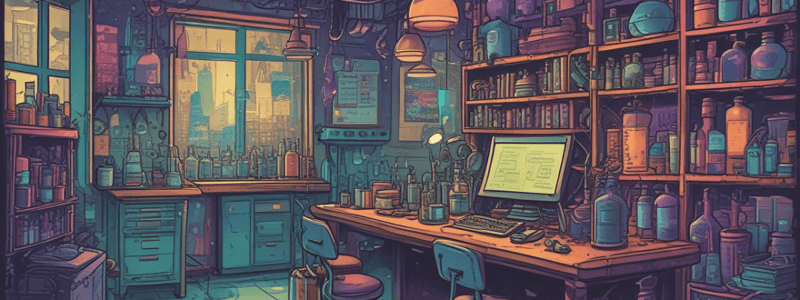Podcast
Questions and Answers
What is the primary component that makes up an atom?
What is the primary component that makes up an atom?
- Protons (correct)
- Neutrons
- Isotopes
- Electrons
What is the difference between isotopes of an element?
What is the difference between isotopes of an element?
- Isotopes have different numbers of protons
- Isotopes have different numbers of electrons
- Isotopes have different atomic weights
- Isotopes have different numbers of neutrons (correct)
Which of the following statements about elements is true?
Which of the following statements about elements is true?
- Elements are substances made up of three types of atoms
- Elements are substances made up of two types of atoms
- Elements are substances made up of multiple types of atoms
- Elements are substances made up of one type of atom (correct)
What is the maximum number of electrons that can be held in the first energy level (shell) of an atom?
What is the maximum number of electrons that can be held in the first energy level (shell) of an atom?
Which of the following is a characteristic of atoms?
Which of the following is a characteristic of atoms?
What is the purpose of electron configurations in describing atoms?
What is the purpose of electron configurations in describing atoms?
Which of the following is a characteristic of metals?
Which of the following is a characteristic of metals?
Which of the following is an example of a nonmetal?
Which of the following is an example of a nonmetal?
What is the primary characteristic of metalloids?
What is the primary characteristic of metalloids?
Which of the following is an example of a metalloid?
Which of the following is an example of a metalloid?
What is the primary purpose of studying the basic concepts of atoms and elements?
What is the primary purpose of studying the basic concepts of atoms and elements?
Study Notes
In Grade 7 Chemistry, students learn about the fundamental units of matter known as atoms and elements. These concepts form the foundation for understanding chemical reactions, compounds, and the entire field of chemistry.
Atoms
Atoms are tiny particles that cannot be divided any further without losing their properties. They consist of three parts: protons, neutrons, and electrons. Protons have a positive charge (+), while electrons have a negative charge (-). Neutrons do not carry a charge and can make atoms heavier.
Isotopes and Elements
Isotopes are different forms of the same element. They differ from each other only by the number of neutrons within the nucleus. For example, carbon has three isotopes: carbon-12, carbon-13, and carbon-14.
Elements are substances made up of one type of atom. There are over 118 known elements, including some that occur naturally and others that are produced artificially. Each element has its own unique set of physical and chemical properties due to the differences in their atomic structure.
Electron Configurations
The arrangement of electrons in an atom is described using electron configurations. These configurations show how many electrons are present in each energy level (shell) around the nucleus. The first shell can hold up to 2 electrons, with subsequent shells holding more depending on their energy level.
Elements
Elements are classified based on their specific characteristics and behaviors. Some common classifications include metals, nonmetals, and metalloids.
Metals
Metals are typically shiny, good conductors of heat and electricity, and tend to lose electrons easily when forming compounds. Examples include iron, gold, and aluminum.
Nonmetals
Nonmetals are usually poor conductors of heat and electricity, and they often gain electrons when forming compounds. Common examples include oxygen, nitrogen, and chlorine.
Metalloids
Metalloids share properties between metals and nonmetals. They generally fall in the middle of the periodic table and exhibit semiconducting properties. Silicon and germanium are examples of metalloids.
By studying these basic concepts, students develop a solid understanding of the building blocks of chemistry: atoms and elements. This knowledge allows them to explore more complex topics as they progress through school and delve deeper into the world of chemistry.
Studying That Suits You
Use AI to generate personalized quizzes and flashcards to suit your learning preferences.
Description
This quiz covers the fundamental concepts of atoms and elements studied in Grade 7 Chemistry. Topics include the structure of atoms, isotopes, elements, electron configurations, as well as classifications of elements such as metals, nonmetals, and metalloids.




